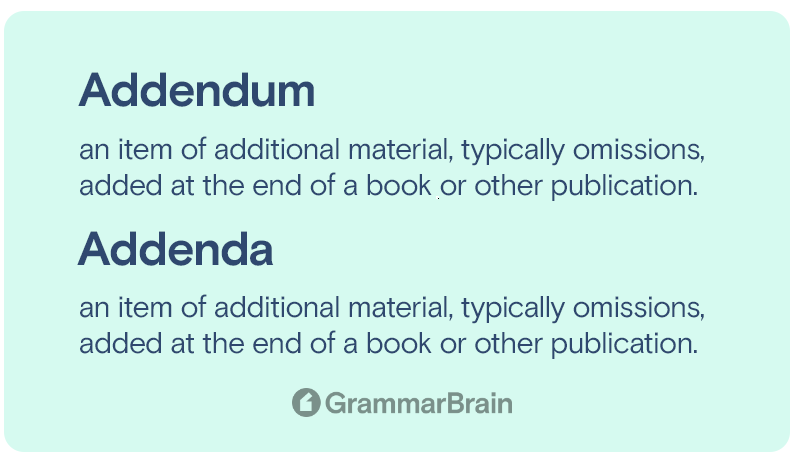Is it addendums or addenda? Have you ever wondered if there’s a difference between addendums and addenda? Then, you are not alone! Even the two words seem to be interchangeable, are they really? What is the difference between addendums and addenda?
Let’s learn the difference in this short guide…
What is the difference between an addendum and addenda?
An addendum is a document added to a contract or other legal document to modify, update, or clarify its content. An addenda is the plural form of “addendum.” Adding an addendum to a document does not change the original document, but it supplements it with additional information.
Addenda are frequently used in contracts to modify the terms of the agreement. For example, a company may add an addendum to a contract to change the deadline for the completion of a project. Addenda can also be used to add new information that was not included in the original document.
Addenda are usually signed by both parties to the contract, and they become part of the contract once they are signed. If an addendum is not signed, it is not legally binding.
| Word | Definition |
| Addendum | an item of additional material, typically omissions, added at the end of a book or other publication. |
| Addenda | an item of additional material, typically omissions, added at the end of a book or other publication. |
How to use addendums and addenda correctly?
An addendum is an addition or supplement to a document that is not essential to its main purpose. An addendum typically contains information left out of the original document though the original document was created.
Addenda, on the other hand, are additions or supplements to a document that are crucial to its main purpose. Addenda typically contain information that was left out of the original document since the original document was created.
When deciding whether to use “addendum” or “addenda,” consider whether the information in question is important to the main purpose of the document. If it is, then you should use “addenda.” If it is not, then you can use “addendum.”
Remember, both terms are plural, so you should use plural nouns. Here are a few examples of how you might use “addendum” and “addenda” in a sentence:
- The addendum to the contract contains information about the new payment schedule.
- The addenda to the book include Errata and a list of recommended further readings.
- I forgot to include the addendum to my report.
- The addenda to the proposal are due by 5:00 p.m. on Friday.
- Please sign and return the attached addendum.
As you can see from these examples, “addendum” and “addenda” can both be used as singular or plural nouns. They can also be used as adjectives, as in the phrase “addendum page”.

The benefits of using addendums and addenda
Addendums and addenda are always used interchangeably, but there are some differences between the two.
An addendum is typically used to make corrections or additions to a document that has already been signed, whereas an addendum can be used for any kind of supplemental information.
Here’s a closer look at the benefits of using each one:
Addendums:
- Can be used to make corrections or additions to a document that has already been signed.
- Do not require all parties to the original document to sign the addendum.
- Are typically shorter than addenda.
Addenda:
- Allow for additional information to be included in a document.
- Must be signed by all parties to the original document.
- Can be used even if the original document has not been signed yet.
- Are typically longer than addendums.
So, what’s the difference between an addendum and an addenda? An addendum is a document that is appended to another document for clarification or explanation.
An addenda, on the other hand, refers to a list of items – typically amendments or changes – that are either proposed or adopted.
In terms of usage, it’s more common to see “addenda” as the plural form of this word (although both are technically correct).
Inside this article
Fact checked:
Content is rigorously reviewed by a team of qualified and experienced fact checkers. Fact checkers review articles for factual accuracy, relevance, and timeliness. Learn more.
Core lessons
Glossary
- Abstract Noun
- Accusative Case
- Anecdote
- Antonym
- Active Sentence
- Adverb
- Adjective
- Allegory
- Alliteration
- Adjective Clause
- Adjective Phrase
- Ampersand
- Anastrophe
- Adverbial Clause
- Appositive Phrase
- Clause
- Compound Adjective
- Complex Sentence
- Compound Words
- Compound Predicate
- Common Noun
- Comparative Adjective
- Comparative and Superlative
- Compound Noun
- Compound Subject
- Compound Sentence
- Copular Verb
- Collective Noun
- Colloquialism
- Conciseness
- Consonance
- Conditional
- Concrete Noun
- Conjunction
- Conjugation
- Conditional Sentence
- Comma Splice
- Correlative Conjunction
- Coordinating Conjunction
- Coordinate Adjective
- Cumulative Adjective
- Dative Case
- Determiner
- Declarative Sentence
- Declarative Statement
- Direct Object Pronoun
- Direct Object
- Diction
- Diphthong
- Dangling Modifier
- Demonstrative Pronoun
- Demonstrative Adjective
- Direct Characterization
- Definite Article
- Doublespeak
- False Dilemma Fallacy
- Future Perfect Progressive
- Future Simple
- Future Perfect Continuous
- Future Perfect
- First Conditional
- Irregular Adjective
- Irregular Verb
- Imperative Sentence
- Indefinite Article
- Intransitive Verb
- Introductory Phrase
- Indefinite Pronoun
- Indirect Characterization
- Interrogative Sentence
- Intensive Pronoun
- Inanimate Object
- Indefinite Tense
- Infinitive Phrase
- Interjection
- Intensifier
- Infinitive
- Indicative Mood
- Participle
- Parallelism
- Prepositional Phrase
- Past Simple Tense
- Past Continuous Tense
- Past Perfect Tense
- Past Progressive Tense
- Present Simple Tense
- Present Perfect Tense
- Personal Pronoun
- Personification
- Persuasive Writing
- Parallel Structure
- Phrasal Verb
- Predicate Adjective
- Predicate Nominative
- Phonetic Language
- Plural Noun
- Punctuation
- Punctuation Marks
- Preposition
- Preposition of Place
- Parts of Speech
- Possessive Adjective
- Possessive Determiner
- Possessive Case
- Possessive Noun
- Proper Adjective
- Proper Noun
- Present Participle
- Prefix
- Predicate



